How to measure luggage for airlines? This process can be tricky, but it’s crucial to avoid unexpected fees at airport check-in. Often, travelers overlook this aspect when preparing for their journey resulting in extra charges.
This article will provide you with effective strategies for accurately measuring your luggage to ensure it aligns with the airline’s baggage policy, potentially saving you a significant amount of money.
Understanding Airline Luggage Restrictions
Navigating through airline luggage restrictions can be daunting, but understanding these limitations is essential for a hassle-free flight. The restrictions generally encompass weight, size, and specific item limitations.
Weight limitations
Airline luggage weight restrictions vary depending on the airline and the class of travel. However, a general rule of thumb for most airlines is that the maximum weight for a checked bag is 50 pounds (23 kilograms). For carry-on luggage, the weight limit typically ranges from 15 to 20 pounds (7 to 9 kilograms).
Exceeding these weight limitations can result in additional fees or the necessity to redistribute your luggage’s contents.

Size limitations
When it comes to the size of your luggage, airlines again have different standards. Most airlines allow checked luggage with total linear dimensions (length + width + height) not exceeding 62 inches (158 centimeters).
Carry-on bags, on the other hand, should fit in the overhead compartment or under the seat in front of you. The typical size limit for carry-on luggage is 22 x 14 x 9 inches (56 x 36 x 23 centimeters).
Additional restrictions
In addition to weight and size restrictions, there are also limitations on what can be packed in your luggage. For instance, liquids in carry-on baggage must be in containers of 100 milliliters or less, and all containers should fit into a single, transparent, resealable 1-liter bag.
Sharp objects like knives or scissors with blades longer than 6 centimeters are not permitted in carry-on luggage. These items must be packed in your checked baggage. It’s always best to check with your specific airline for detailed restrictions.
How To Measure Luggage For Airlines: Step-By-Step Instructions
Tools Needed For Measuring Luggage
Having the right tools on hand can make the process of measuring your luggage much simpler.
Tape Measure
A tape measure is an essential tool for measuring luggage dimensions. A flexible and retractable tape measure allows you to measure different parts of the luggage, including those with irregular shapes.
This allows you to check the length, width, and height of your luggage, including any handles, wheels, or protrusions. Make sure to measure your suitcase from its widest points to ensure accuracy.
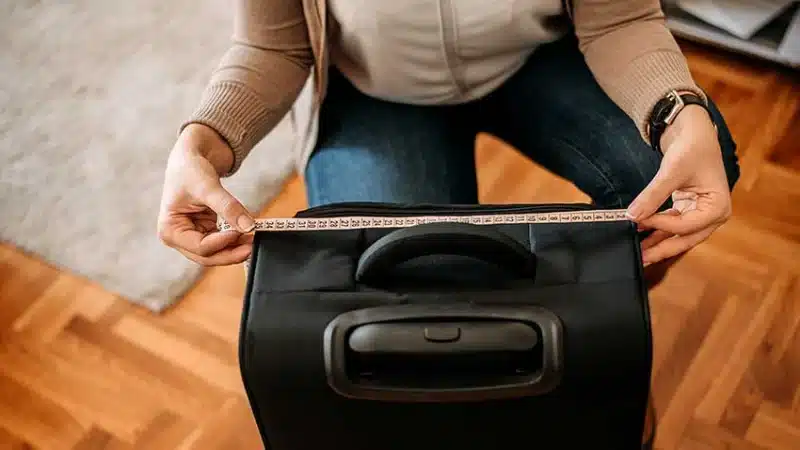
Weighing Scale
An accurate weighing scale is needed to ensure your luggage meets the weight restrictions set by airlines. Remember to weigh your luggage after packing to avoid any surprise overweight fees at the airport.
Different airlines may have varying weight limits, so it’s crucial to check these specifications before your trip.
Luggage Strap or Belt
A luggage strap or belt can be handy when measuring your luggage. This is particularly useful if your luggage does not have a defined shape, as the strap can be used to obtain a more accurate measurement.
Steps To Measure Luggage Properly
Once you have all the necessary tools, you can begin the process of measuring your luggage.
Step 1: Measure The Length, Width, And Height
The length, width, and height of your luggage play a critical role in determining whether it meets airline regulations. Make sure to include handles, wheels, or other protrusions in your measurements.
Measure from the ground to the highest point for the height, the widest point for the width, and from one end to the other for the length.

Step 2: Calculate The Overall Dimensions
To calculate the overall dimensions, simply add the length, width, and height measurements. Many airlines use this total linear dimension to determine if a piece of luggage can be carried on board. Make sure your total dimensions do not exceed the airline’s limit.
Step 3: Weigh The Luggage Accurately
Pack everything you plan to bring on your trip into your luggage before weighing. Place your luggage on the weighing scale to determine its weight.
Make sure the scale is on a flat, stable surface for an accurate reading. If your luggage is over the weight limit set by your airline, you may need to remove some items to reduce their weight.
Preparing For Airline Security Checks With Your Luggage
Navigating airport security can be a daunting task, particularly for those unfamiliar with the process. As such, preparation is key to ensuring a smooth and stress-free experience.
This guide will provide you with practical tips and advice on how to prepare your luggage for airline security checks.
Understand the Luggage Policies
Before packing your luggage, it’s crucial to familiarize yourself with the luggage policies of your respective airline. Each airline has its own set of rules concerning what you can and can’t carry the weight limit, and the dimensions of your luggage.
Overlooking these rules could result in additional charges or having to leave items behind at the security checkpoint.
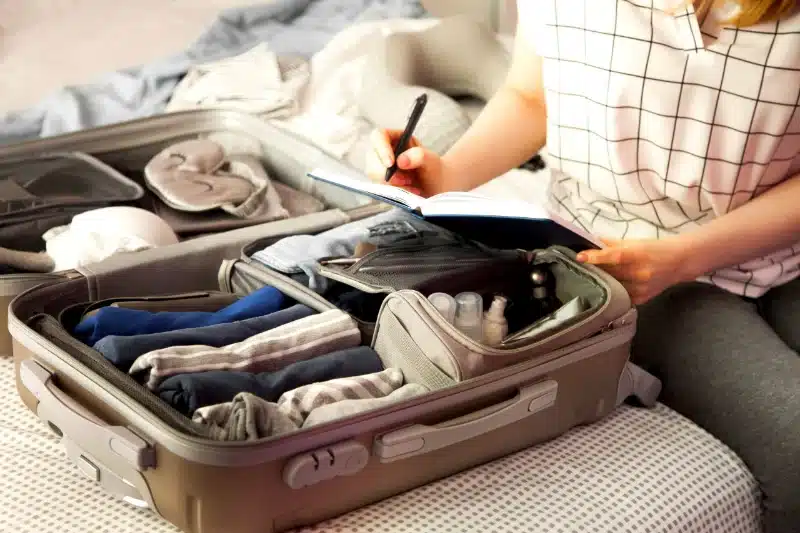
Packing Liquid Items
One of the most common hiccups at airport security involves the packing of liquids. According to the Transportation Security Administration (TSA), all liquids, aerosols, gels, creams, and pastes must be in 3.4 ounces (100 ml) containers or smaller, and they all must fit in a single quart-sized clear plastic bag.
Anything exceeding these limits should be packed in your checked luggage.
Electronic Devices
Most security checkpoints require passengers to remove all electronic devices larger than a cell phone from their carry-on for separate screening. These may include laptops, tablets, e-readers, and cameras. To expedite this process, pack these items in easily accessible areas of your luggage.
Prohibited Items
Understanding what items are prohibited is a critical part of preparing for a security check. The TSA provides a comprehensive list of prohibited items on its website.
Some items, such as firearms, certain types of razors, and some sporting goods, are only allowed in checked baggage. Other items, like explosives and flammable materials, are entirely prohibited.
By adhering to these guidelines and taking the time to prepare your luggage properly, you can make the security process quicker and easier, allowing you to start your travel journey on a positive note.
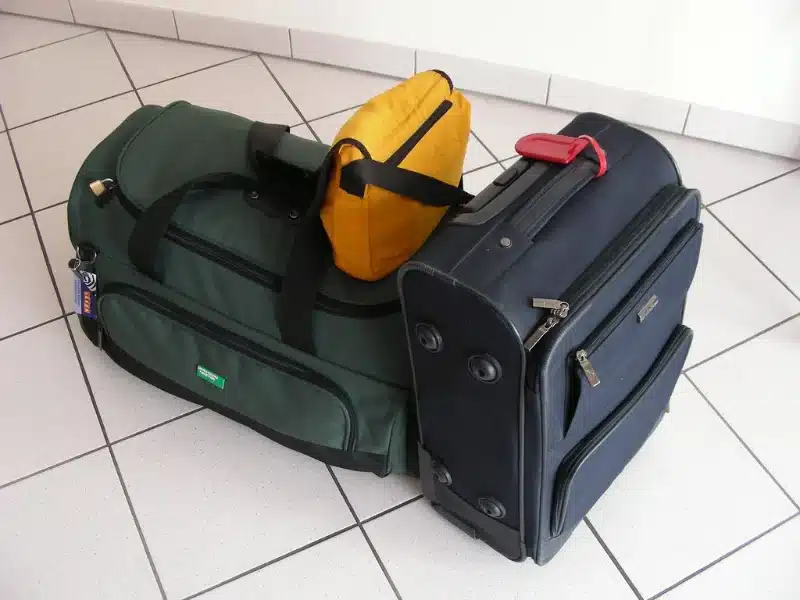
Dealing With Overweight Or Oversized Luggage
When preparing for a trip, the issue of handling overweight or oversized luggage can be a substantial concern. It’s crucial to manage your luggage efficiently to avoid unexpected expenses and inconvenience.
This section provides a comprehensive guide on how to deal with such situations effectively.
Checking The Airline’s Specific Policies
Every airline has specific baggage policies that dictate the weight and size limits for checked and carry-on luggage. It’s crucial to familiarize yourself with these guidelines before packing. Overlooking this step can lead to unexpected expenses and inconvenience at the airport.
Baggage Allowance
Each airline has a standard baggage allowance, which usually includes a specific weight and size limit for both checked and carry-on luggage. You will need to ensure your luggage complies with these restrictions to avoid any additional charges.
Excess Baggage Fees
If your luggage exceeds the airline’s standard allowance, you may have to pay excess baggage fees. These costs can significantly increase your travel expenses, so it’s best to avoid overweight or oversized luggage whenever possible.
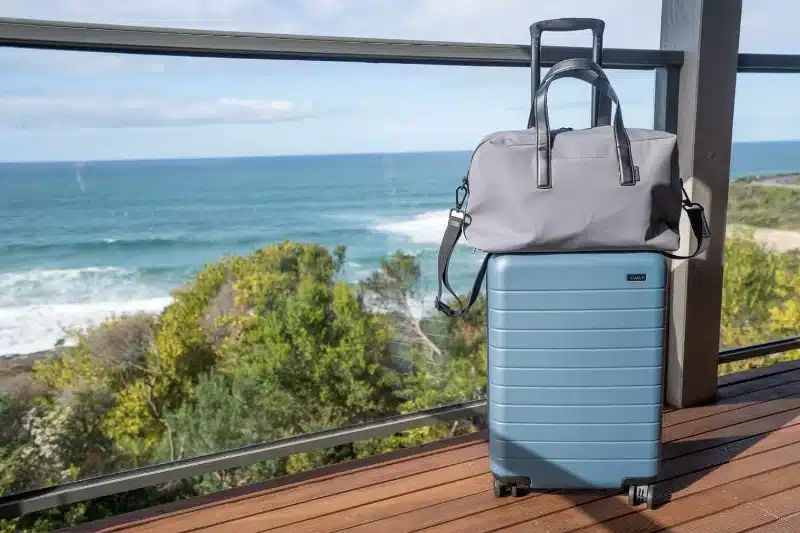
Options For Reducing Weight Or Size
There are several strategies to reduce luggage weight or size if you find yourself over the limit. These strategies can be particularly helpful in avoiding excess baggage fees and ensuring a smooth travel experience.
Unpacking And Repacking Essentials
When examining the contents of your luggage, take a careful inventory to identify the essentials for your trip. Consider the duration of your stay, the weather, and any specific activities you have planned.
Remove any non-essential items that may weigh you down. By repacking your bag efficiently, you can ensure that your baggage does not exceed the weight limit.
Distributing Items Among Multiple Bags
If you’re traveling with multiple bags or with other people, it’s important to distribute the weight evenly among all the bags. By doing so, you can ensure that no single bag exceeds the weight limit set by airlines or transportation authorities.
This practice not only helps avoid any potential surcharges or penalties but also promotes better balance and stability during your journey. So, pack smartly, distribute the weight evenly, and travel hassle-free.
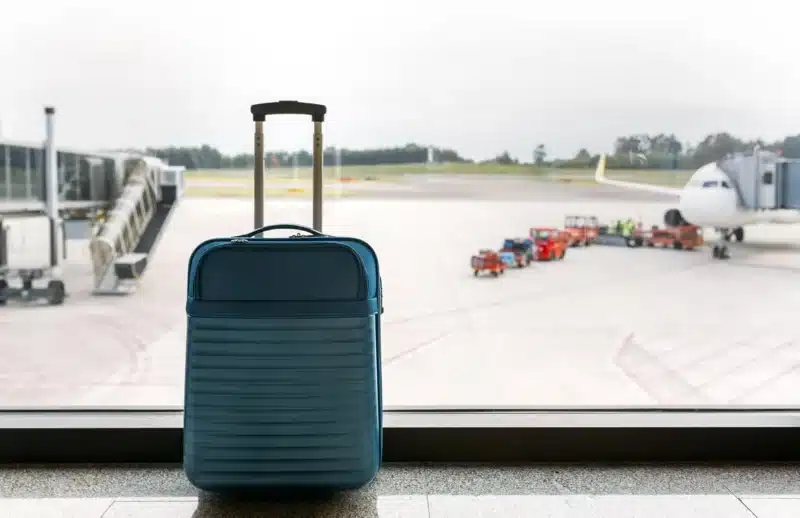
Shipping Excess Luggage
If other strategies don’t work or aren’t practical, consider shipping excess luggage to your destination. Although there may be fees associated with this service, they can be significantly less than the charges levied for overweight or oversized luggage by airlines.
Plus, the convenience of having your items delivered directly to your destination can greatly enhance your travel experience.
Tips For Avoiding Luggage Measurement Issues
Choose Lightweight Luggage
Choosing lightweight luggage is one of the most effective strategies to avoid luggage measurement issues. Many airlines have strict weight limitations for checked and carry-on bags.
By selecting luggage made from lightweight materials such as polycarbonate or nylon, you can ensure that the majority of your baggage weight allowance is reserved for your belongings rather than the suitcase itself. Lightweight luggage is also easier to handle and transport, making it a practical choice for travelers.
Consider Collapsible Or Expandable Luggage Options
Collapsible or expandable luggage options offer significant advantages for travelers wanting to stay within measurement guidelines. These types of luggage can adapt to the volume of your belongings, reducing wasted space and helping to maintain a compact profile.
They are particularly useful for trips where you may return with more items than you started with, such as shopping trips or vacations where you may be bringing back souvenirs.

Use Packing Cubes Or Compression Bags
Utilizing packing cubes or compression bags can dramatically improve the efficiency of your packing, allowing you to fit more items into a smaller space. These tools compartmentalize your luggage, minimizing the wasted space that can occur when items are packed loosely.
Additionally, they can help to prevent items from moving during transit, reducing the risk of damage. Compression bags go a step further by reducing the volume of items such as clothing, further increasing your packing efficiency.
Packing Strategies
When preparing for a trip, efficient packing strategies can make all the difference. By organizing your belongings systematically, you can maximize space, protect your items, and ensure you have everything you need.
Adopt a List Approach
Firstly, consider adopting a list approach to your packing. Having a well-structured list can ensure nothing is forgotten, and you can check items off as you pack them. This strategy can be particularly beneficial for extensive trips or those that require specialized gear.
The Layering Method
Another strategy involves the layering method. Begin your packing process by placing heavy, less fragile items at the bottom of your suitcase or backpack, and gradually add lighter items on top. This arrangement not only keeps your luggage balanced but also helps to protect delicate items from getting crushed.
Utilizing Packing Cubes
Utilizing packing cubes can be an absolute game-changer. These small, zippered bags help to compartmentalize your packed items, keeping them neat and accessible throughout your journey. Plus, they often compress your items, allowing you to fit more into your bag.
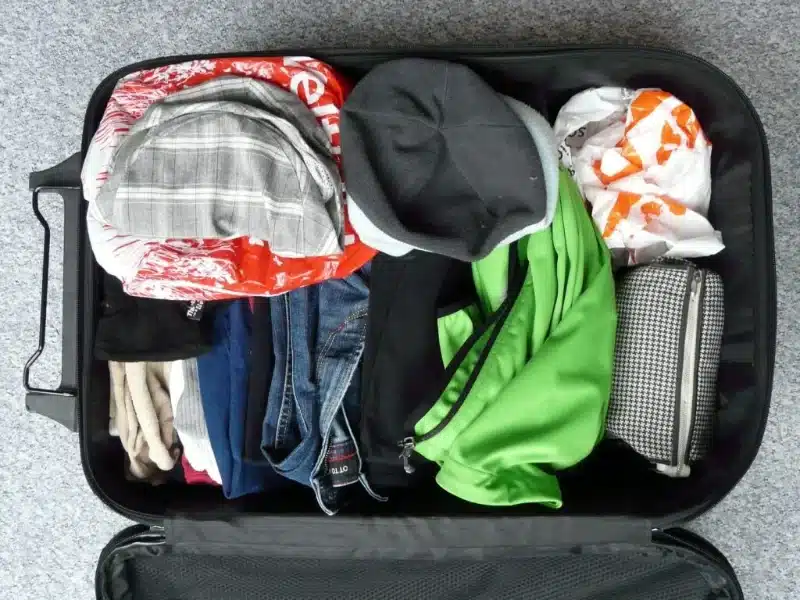
FAQs
How Are Luggage Dimensions Measured For Irregularly Shaped Items?
Luggage dimensions for irregularly shaped items are typically measured using the same linear dimensions method as used for regular items – height, width, and depth. However, the process can be slightly more complex due to the unconventional shape.
Let’s consider a guitar case as an example of an irregularly shaped item. The height would be determined by measuring from the bottom to the top of the case when it’s standing upright.
The width is measured across the broadest part of the case, usually where the body of the guitar would be. The depth is calculated by measuring the thickest part of the case, from front to back.
It’s crucial to include any protruding pieces in these measurements, such as handles or wheels, as most airlines include these in their size restrictions.
Remember, the sum of these three dimensions (height, width, and depth) generally needs to be under a specific limit, often 62 linear inches for many airlines, although this can vary, so it’s always best to check with the specific airline.
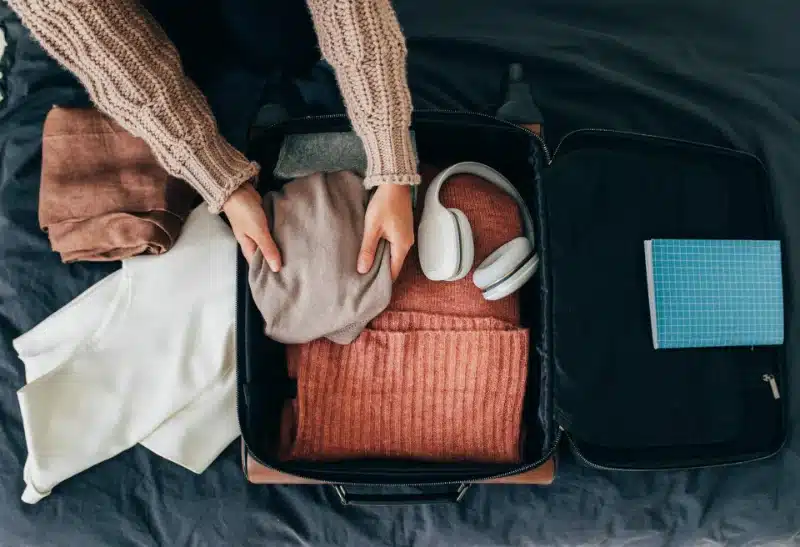
Why Do Airlines Have Size And Weight Restrictions For Luggage?
Airlines enforce size and weight restrictions for luggage due to several reasons, the key among them being safety, fuel efficiency, and space considerations.
From a safety perspective, the weight of a plane is a critical factor that influences its ability to take off, maneuver, and land. By controlling the weight of luggage, airlines can ensure that the aircraft maintains its balance and does not exceed its maximum allowable weight. Excessive weight can also affect the plane’s center of gravity, which plays a pivotal role in its flight dynamics.
Fuel efficiency is another major factor. Heavier planes require more fuel to operate, and with fuel being one of the most significant costs for airlines, efficient use is a priority. By maintaining strict control over luggage weight, airlines can manage their fuel consumption more effectively.
Space within the aircraft is limited. Overstuffed, oversized luggage can pose a problem in terms of storage, impacting the comfort and convenience of other passengers. By enforcing size restrictions, airlines can ensure that all passenger luggage fits in the overhead bins or under the seat, thereby facilitating a smoother and more comfortable flying experience for everyone on board.
These restrictions are not arbitrary but are in place for very pragmatic reasons related to safety, cost-efficiency, and passenger comfort.

Do Different Airlines Have Different Size And Weight Restrictions For Luggage?
Yes, different airlines indeed have different sizes and weight restrictions for luggage.
These regulations are implemented based on factors such as the type of aircraft, the number of passengers, the duration of the flight, and even the airline’s specific policies.
For instance, a domestic airline may permit a maximum weight limit of 50 pounds for checked baggage, while an international carrier may allow up to 70 pounds. This is why passengers must check the luggage guidelines of their specific airline before packing for their trip.
In terms of size, most airlines measure the total dimensions of a bag (length + width + height) rather than individual dimensions. A common restriction for checked luggage is 62 linear inches, although this can vary.
For carry-on baggage, airlines typically have stricter limitations to ensure that all bags can safely fit into the overhead bins or under the seat in front.
Exceeding these limits incurs additional fees, which can significantly increase the cost of a trip. Therefore, travelers are advised to pack efficiently, utilize luggage scales, and make the most of their carry-on allowance.
Remember, every airline’s luggage policy is subject to change, so it’s best to review the most recent guidelines on their official website before you travel.
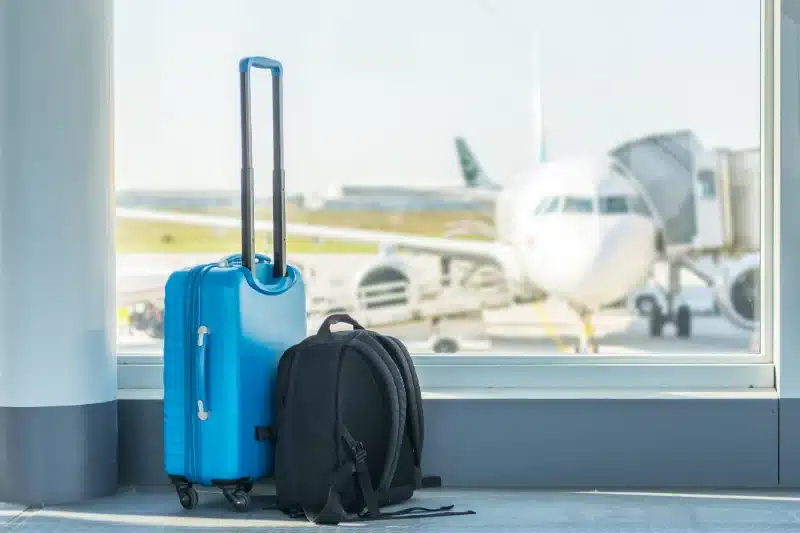
What Happens If My Luggage Exceeds The Airline’s Size Or Weight Restrictions?
If your luggage exceeds the airline’s size or weight restrictions, you will usually be required to pay an excess baggage fee. This fee is typically determined by the weight of the luggage, with heavier bags incurring higher costs.
However, the exact amount can vary considerably depending on the airline, the destination, and whether your flight is domestic or international.
Many airlines also impose a maximum limit for checked luggage, which is typically around 50 to 70 pounds (23 to 32 kilograms) per bag. If your luggage exceeds this limit, you may be asked to redistribute the weight among your other bags or remove some items entirely.
Furthermore, bags that exceed the airline’s size limits (usually calculated by adding the dimensions of the length, width, and height) may need to be shipped as cargo, which can be significantly more expensive.
It’s also important to note that not all airlines handle excess baggage in the same way. Some may allow you to pay for extra weight or size at the airport, while others may require you to book in advance.
Ultimately, the best way to avoid these issues is to check the airline’s baggage policy closely before you travel, pack as lightly as possible, and measure and weigh your luggage to ensure it complies with the airline’s restrictions.
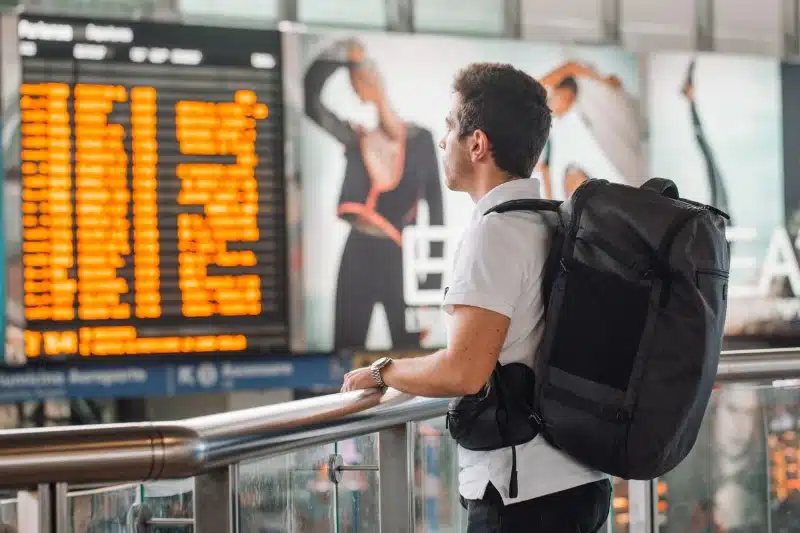
Is There A Standard Size For Personal Items Like Backpacks Or Purses On Most Airlines?
Yes, most airlines do have standard-size guidelines for personal items such as backpacks or purses.
While these exact dimensions can vary slightly depending on the airline, a general guideline is that a personal item should fit under the seat in front of you. Commonly, the dimensions hover around 18 inches x 14 inches x 8 inches, but it’s always recommended to check with your specific airline before packing.
Personal items encompass a wide variety of object types, including but not limited to backpacks, laptops, purses, briefcases, or small duffel bags. Items that typically do not count towards your allowance are things like outer garments (coats, hats), food & drink purchased after the security checkpoint, or assistive devices (wheelchairs or child strollers).
It’s worth noting that the enforcement of these size restrictions can sometimes depend on the flight’s capacity. For example, on a less crowded flight, overhead bin space may be less of a concern, and flight attendants might be more lenient with slightly larger personal items.
However, to ensure a smooth travel experience, it’s always best to adhere to the airline’s posted size guidelines for personal items.
Conclusion
Knowing how to measure luggage for airlines effectively is an essential skill for travelers wishing to avoid accruing unnecessary fees. By staying informed of airline specifications and investing in accurate luggage measurement tools, you can ensure your belongings fit within the required dimensions.
Therefore, the next time you pack for a trip, remember these tips to sidestep those extra costs and enjoy a smoother, more cost-effective travel experience.